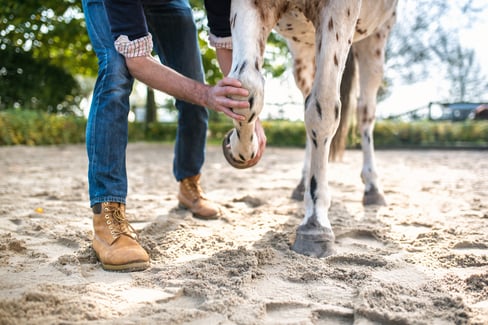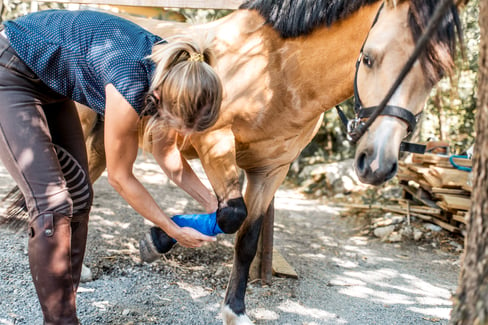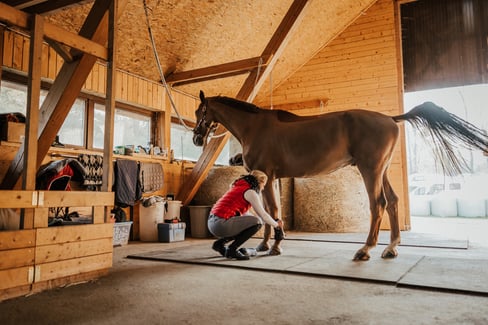Table of Contents
Like athletes who experience muscle and joint injuries from too much training and movement, racehorses, dressage horses, and other performance horses can also suffer joint pain, potentially leading to more serious injuries.
Take a horse fetlock injury, for example.
Fetlock injuries are most common in performance horses, especially when they place too much load on their fetlocks when traveling with speed, turning on uneven ground, and jumping over obstacles. Without proper management and prevention, fetlock injuries can even lead to bone fractures, which at best just affect your horse’s lifestyle and, at worst, result in severe disability or death.
In this guide, we’ll go in-depth into horse fetlock injuries, their signs and causes, and the best treatment and prevention methods to protect your stallions and ponies from experiencing severe pain and discomfort.
What Is a Horse Fetlock Joint
A horse fetlock is a type of hinge joint found in the animal’s four legs, between the pastern and the cannon bone. It works similarly to a human ankle and is supported by various tendons and ligaments. These soft tissues are essential to help the horse’s locomotion.
Fetlocks are high-motion joints subjected to significant forces and compression during horse movements.
In the event of an injury, the damage also significantly impacts the soft tissues surrounding the fetlock, resulting in the horse’s inability to carry his entire weight. Hence, the animal feels extreme pain and cannot move appropriately.
Understanding a Fetlock Joint Horse Injury
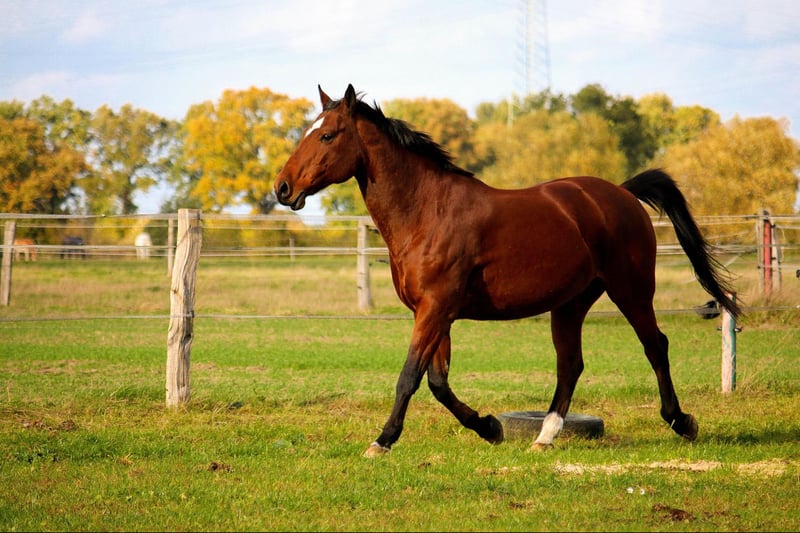
A fetlock joint injury occurs because of severe strain on the horse’s legs due to galloping, jumping, or turning at high speeds. As a result, a horse fetlock injury is more common in active horses, especially in performance racehorses.
Fetlock joint injuries in horses can be broken down into two categories:
- When the specific injury happened once
- When the disorder has worsened over an extended period
Specific joint injuries can occur when your horse has fallen, slipped, or pulled up. But if the animal has gradually slowed down movements or shown early lameness signs, the disorder may be a degenerative problem. Knowing the exact type of joint injury and damage is essential to identify the best treatment possible to move forward.
Common Types of Fetlock Joint Horse Injuries
Horse fetlock damage can usually be broken down into a few distinct types:
- Fetlock sprain: a tear or strain to the horse’s suspensory ligament, where the ligament attaches to the fetlock’s base.
- Sesamoid bone injury: refers to injury of the two small bones at the back of the fetlock joints called the sesamoid, which can be affected by a fetlock injury. The sesamoids are anchors for the suspension structures surrounding your horse’s foot and fetlock, allowing them to move correctly. Unfortunately, sesamoid injuries are difficult to repair and, in some cases, cannot be repaired.
- Fetlock fractures: considered the most severe fetlock joint injury and are the worst possible scenario in jumping and active horses. The most common sign of a fetlock fracture is a sudden and severe weight-bearing pain or lameness after an exercise or a competition. Swelling is significant, and the horse experiences intense pain when moving or bending the joint.
Any fetlock injury can lead to joint inflammation, such as capsulitis or synovitis, and the supporting ligaments can also be inflamed, as in the case of sesamoiditis. During this stage, the horse might show signs of lameness and decreased motion.
There are also instances when an inflammation of the fetlock joint does not warrant treatment. This happens in conditions like windgalls or leg filling, where you might observe the area around the fetlock swollen. In this case, only careful management and rest can prevent any injury from occurring.
Signs of Lameness in Fetlock Injury
Lameness is one of the early signs of a horse fetlock injury because the joint is weight-bearing. Visible damage can be observed because the surrounding soft tissues only have limited covering for protection. You’ll likely feel heat on the area and see swelling, along with other recognizable signs:
- Effusion (swelling within the capsule)
- Edema (swelling within the surrounding soft tissues)
- Cannot bear weight on the involved leg
- Pain upon palpation
- Reduced movement
How Fragile Is a Horse Ankle Bone
The fetlock joint, which is a key part of the horse’s ankle, can be a fragile and vulnerable body part.
When you take a look at a horse’s anatomy, the lower limbs and the fetlock joint are more delicate and slender in relation to the size of their body. Horses are heavy; therefore, the limbs almost always bear a significant amount of their weight.
Stress and strain also contribute to the ankle bone’s vulnerability. The fetlock joint becomes susceptible to strain during jumping or running movements, especially because of the constant extension and flexion.
Muscle imbalance and poor conditioning can also increase or decrease the fetlock joint’s fragility. The more conditioned and developed the leg muscles are, the better the horse’s ankle bone can withstand force and compression.
What to Consider When Treating a Horse Fetlock Joint Injury
You will only know the proper way to treat a horse fetlock joint injury with proper diagnosis. A professional musculoskeletal examination should always be the first step with the help of your vet. The doctor will palpate the area for any signs of pain, swelling, or heat and will also intentionally passively flex the limb to assess the range of motion.
After an initial exam, your vet conducts a lameness exam, where the horse is guided to move in a circle and straight line. Another flexion test can also simulate stress on the fetlock joint.
When the vet confirms the lameness is connected with a horse fetlock injury, they may order other diagnostic exams like radiographs to assess bone changes, including osteoarthritis and fractures. Soft tissue ultrasound can also help determine the extent of the injury to the surrounding ligaments, tendons, and joint capsule.
Treatment modalities must also depend on the severity of the horse fetlock injury. Conservative management, such as enough rest, is ideal for minor sprains or strains, while more severe damage may warrant surgical intervention.
However, regardless of the extent of the joint injury, it’s always essential to consider the amount of rest and recovery your horse needs. Controlled muscle exercises and proper rehabilitation can help horses regain joint mobility and strength.
Consequences of Not Treating a Horse Fetlock Sprain
Even though the fetlock joint is only a tiny part of a horse’s limbs, properly managing it during injuries is critical to the animal’s health.
Without a proper diagnosis, enough rest, rehabilitation, medication, and vet care, even a superficial ankle injury can lead to more severe issues:
- Prolonged pain and discomfort resulting in a reluctance to move
- Chronic lameness that prevents the horse from engaging in athletic activities
- Joint degeneration that can lead to degenerative joint disease or osteoarthritis if left untreated
- Behavioral changes that make the horse less cooperative, more aggressive, and anxious
- Reduced quality of life that affects the horse’s overall well-being and happiness
How to Deal With Equine Fetlock Joint Pain
After confirming your horse has fetlock joint pain, it’s vital to maintain constant communication with the vet. The animal’s doctor will identify the amount of rest, rehabilitation, and medications your horse needs to recover fully.
Rest and Isolation
Rest and isolation are two of the most critical measures for a horse with a fetlock injury. You must isolate the injured horse in a small paddock or a stall so the animal will limit his movement. This gives the joint enough time to heal. Consult your vet for proper guidance on the duration of rest needed.
Pain Management
Pain-relief medications can serve as an adjunct to reduce the pain your horse feels. The most common are the non-steroidal anti-inflammatory drugs (NSAIDs), which can also help reduce inflammation. Always follow the prescribed dosage.
Joint Supplements
Another important part of treating a horse fetlock joint injury is giving your horse joint supplements. These essential additions to your horse’s daily diet can significantly improve their joint health and sometimes even get them off of using NSAIDs. Getting your horse off of painkillers is beneficial because prolonged use can result in kidney and liver problems.
TRI-ACTA H.A. for equine is specially formulated with 100% natural ingredients to support your horse’s joints. Unlike most equine joint supplements, TRI-ACTA H.A. contains two types of glucosamine; sulfate, and HCl, which provide unique benefits for your horse. Sulfur is an essential component of joint health, which is provided by glucosamine sulfate. Glucosamine HCl is a highly bioavailable form of glucosamine, meaning your horse can reap the ingredient's benefits faster. Plus, TRI-ACTA H.A. contains hyaluronic acid, which increases the viscosity of the synovial fluid in the joints, allowing for easier and pain-free movement.
TRI-ACTA H.A. for Equine
Our maximum strength formula is perfect for horses that are ageing, experiencing arthritis and stiffness, are in training and competition, or under a heavy workload.
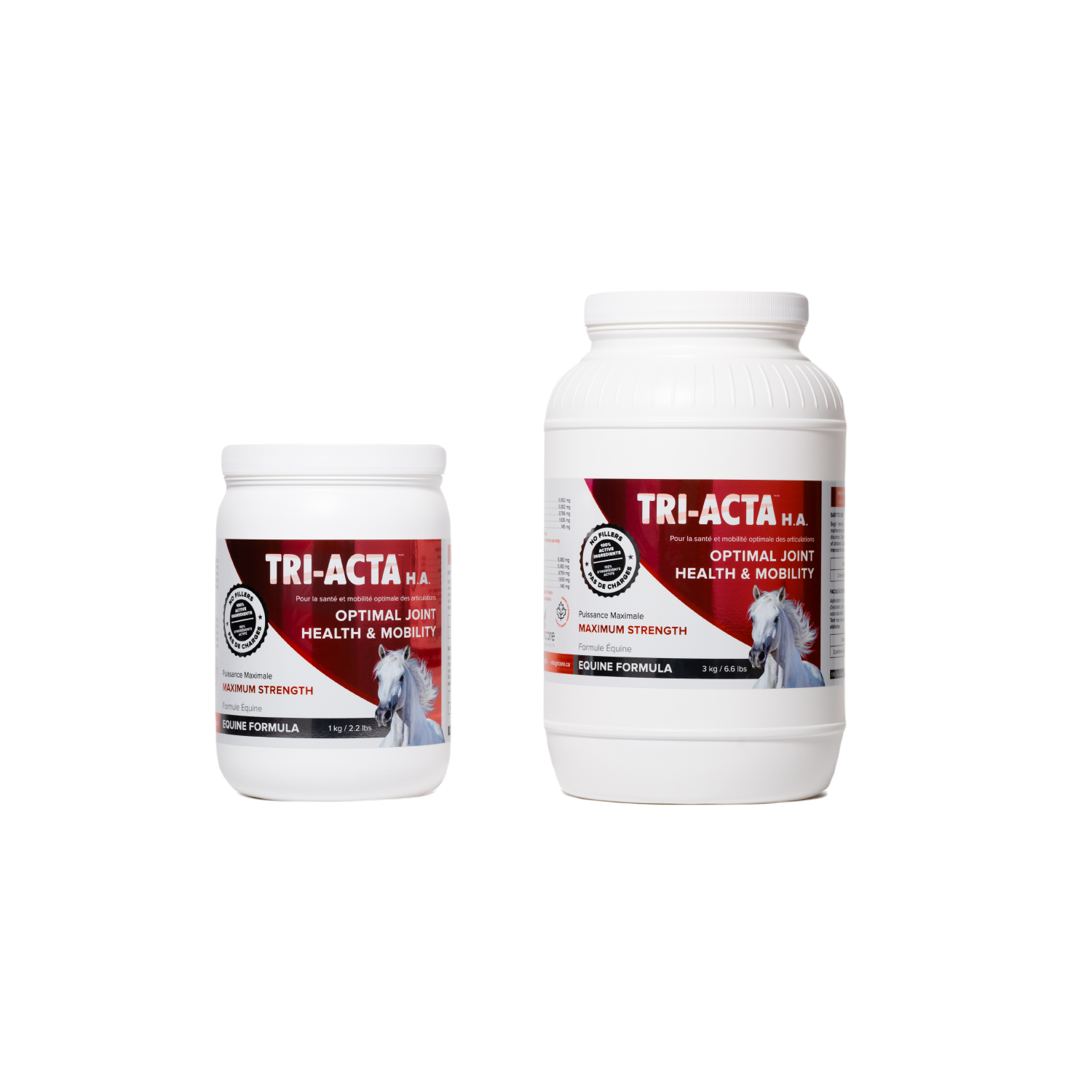
Cold Therapy
A cold compress can also help reduce the joint’s pain and swelling. Always protect the horse’s skin and avoid direct contact with the ice when placing ice packs. Depending on your vet's recommendations, cold therapy should be applied for short periods.
Physical Therapy and Rehabilitation
A rehabilitation program is best when acute pain subsides, where the horse must engage in controlled and structured exercises. Physiotherapy can also help the equine regain his mobility and strength, but it’s always essential that a professional oversees the entire rehabilitation.
Hoof Care
Hoof care can also help speed up the recovery because it helps evenly distribute the weight and stress on the equine’s fetlock joints. Always make sure the horse’s hooves are properly trimmed and well-balanced.
Nutrition
Even the equine’s nutrition matters. Always provide a well-balanced diet to support the animal’s road to recovery and improve his overall health. The horse’s nutritionist and vet should help you with the nutrients the animal needs.
Supportive Wraps
There are also available supportive wraps that can help provide stability to horses with fetlock injuries, reducing pain and lameness. An equine specialist is the best individual to consult regarding the supportive gear your horse needs.
Prevention of Horse Fetlock Injuries

Your horses cannot totally avoid experiencing fetlock injuries, but there are preventive measures that decrease the risk of these injuries. The first step is ensuring the animal has properly balanced feet to prevent hyperextension of the joint, which can lead to straining.
You must also regularly check the horse’s hooves for collapsed heels and other issues because these are risks of injury. Book regular farrier care for your equines to help trim and balance feet and shoes.
Farriers are specialists that can manage hoof health problems to ensure the animal does not encounter lameness and joint issues.
Training periods should also be balanced, minimizing over-exertion of the horse’s ankle bone. Your equine must not experience overloading of the fetlock joints from frequent jumping. Regular vet check-ups are also essential to watch out for any health issues.
Supplements for Strengthening Fetlock Joint in Horse
Dietary equine supplements are also helpful in supporting your equine’s joints and mobility, together with a balanced diet.
The following are the common mechanisms of action these adjuncts can provide your horses:
- Slow the rate of cartilage deterioration
- Increased collagen and protein synthesis
- Improve hyaluronic acid synthesis to produce synovial fluid
- Reduce inflammation
- Manage pain and discomfort
|
Dietary Supplement |
Purpose |
|
Glucosamine Sulfate and HCl |
|
|
Methylsulfonylmethane (MSM) |
|
|
Chondroitin Sulfate |
|
|
Hyaluronic Acid |
|
TRI-ACTA H.A. for Equine
Our maximum strength formula is perfect for horses that are ageing, experiencing arthritis and stiffness, are in training and competition, or under a heavy workload.

Summary
The next time you observe your horse sore or lame after a competition, it’s time to consult the vet for proper assessment and diagnosis. Fetlock injuries are easily treatable during early diagnosis.
Good horse care and management are a must to prevent this joint injury! This includes proper conditioning, balanced nutrition, regular exercise, hoof care, maintaining suitable footing, and engaging in training techniques.
Regular veterinary check-ups, weight management, cross-training, and rehabilitation in case of injury are also important. Plus, dietary supplements like glucosamine, chondroitin sulfate, methylsulfonylmethane (MSM), and TRI-ACTA supplements can also support joint health in horses, aiding cartilage formation, reducing inflammation, and promoting joint flexibility.
Purchase TRI-ACTA H.A. online or learn where to buy at a store near you.
Newsletter Signup
Subscribe to our newsletter to receive the latest news and exclusive offers.
.jpg?height=2000&name=Cliick_Integricare-DISPLAY-REVISEDV2%20(1).jpg)
Proactive & Therapeutic Joint Supplements
When given daily, Integricare joint supplements recover bone and joint injuries faster and help prevent mobility injuries from happening in the first place.








